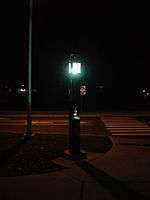Emergency telephone



An emergency telephone is a phone specifically provided for making calls to emergency services and is most often found in a place of special danger or where it is likely that there will only be a need to make emergency calls.
Roadside emergency telephones
Although it is difficult to determine when and where the earliest highway emergency phones were developed, undoubtedly one of the earliest examples were the freeway phones developed in Western Australia in 1966. This system was developed by Alan Harman, an employee of a Western Australian security firm, Central Station Security Company, Electronic Signals Pty Ltd, who came up with the idea after reading of a pile-up on the Kwinana Freeway. The newspaper article mentioned that assistance had been difficult to provide to those involved in the pile-up. The system Harman envisaged was a series of telephone units in a box on a short post, spaced every 160 metres (0.1 mi) on Perth’s freeways. Picking up the handset would trigger an alarm in the Main Roads control centre and police, fire or ambulance could then be determined by the caller. Harman developed the system with the approval of the Main Roads Commissioner and Chief Engineer, by adapting the existing design of communication facilities used at the security firm in which he worked.[1]
Emergency telephones are commonly found alongside major roads throughout the world. In the United Kingdom, orange "SOS" call boxes are spaced every 1.6 kilometres (1 mi) on all motorways as well as some major "A" roads, with roadside markers indicating the nearer phone. Emergency telephones were installed every 0.25 miles (400 m) on all limited-access highways ("Freeways") throughout Southern California in the United States as far back as the 1970s. In Melbourne, Australia, emergency telephones were introduced on metropolitan freeways in 1976, originally on the Tullamarine, South Eastern and Lower Yarra (West Gate) Freeways.[2] On Italian "Autostrade" ("Motorways"), "SOS" emergency phones, generally coloured in yellow, are found spaced every 2 kilometres (1.2 mi).
As cell phone use continues to increase, the need for emergency telephones declines and they are being phased out in many cities.[3] In California, freeway call boxes were used about 98,000 times in 2001. That number dropped by 80% to 20,100 times in 2010, or about 1 call per box per month. The cost of freeway call boxes for the Service Authority for Freeways and Expressways (SAFE) program in the San Francisco Bay area is $1.7 million annually.[4]
These telephones are almost always marked by a placard or sign indicating a unique serial number or identifier which allows the authorities to know exactly where the caller is - even if the caller does not know - by having the caller read the short identifier from the placard over the telephone. Some phones are equipped with the equivalent of caller id and the agent receiving the call can identify the location even if the caller cannot. In most U.S. states with roadside call boxes, the call box placard has the route's milepost reading. In California, call boxes are identified by their mileage through individual counties using postmiles for reference. Each box has a 2-letter identifier for the county, followed by the route number, then a 3 or 4 digit number corresponding to the route's postmileage in tenths of miles.
Other common locations for emergency telephones
Emergency phones can also be found at the ends of bridges or near cliffs which have a history of suicides. These are generally routed directly to appropriate support agencies such as The Samaritans in the UK. They are also occasionally found along the coastline where members of the public may wish to report swimmers or boats in danger at sea. In the UK such phones connect directly to the Coastguard. Emergency phones are also found in elevators where entrapment is very common. These connect to an operator who can help people escape the stopped elevator.
Some car models have an SOS button that connects them to the car company's emergency center. If the car crashes, and the airbags inflate, then the emergency phone inside the car activates, even if the occupant(s) cannot reach it.

In some countries, they are also found in places where people may feel vulnerable or unsafe at night. They are commonly found on university campuses. These are generally linked to security companies who patrol the streets where the phones are located.
See also
References
| Wikimedia Commons has media related to Emergency telephones. |
- ↑ Humble beginnings for freeway phones (July 1998). Western Roads: official journal of Main Roads Western Australia, 21(2), p.18. Perth: Main Roads Western Australia, 1998.
- ↑ Country Roads Board Victoria, Sixty-Third Annual Report: for the year ended 30th June, 1976, Burwood, Victoria: Brown, Prior, Anderson, 1976
- ↑ Orange County Register, "500 freeway call boxes set to make an exit" May 17, 2005
- ↑ Cabanatuan, Michael (May 1, 2011). "Highway call boxes becoming obsolete". San Francisco Chronicle. Retrieved March 19, 2013.